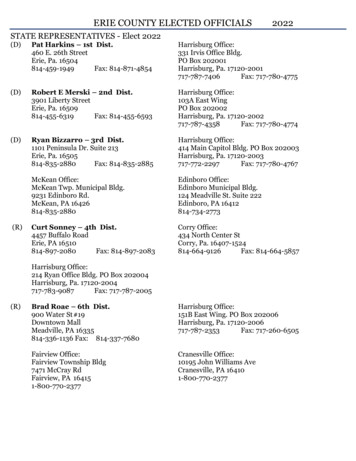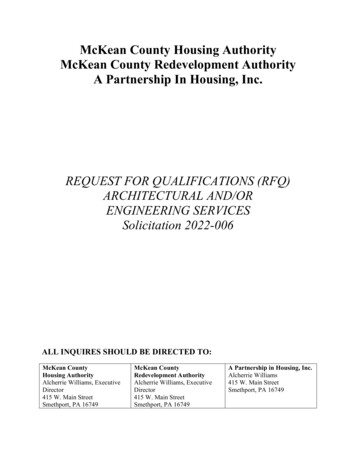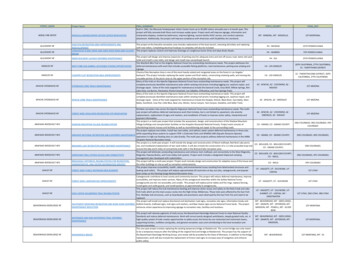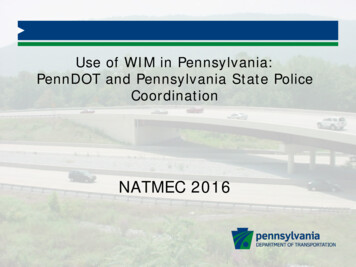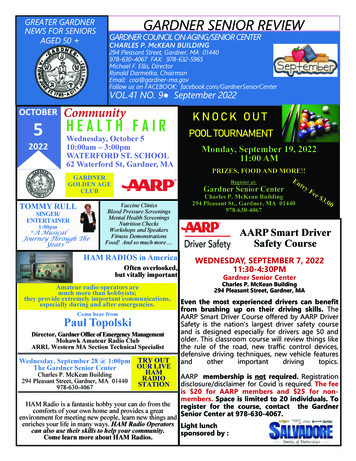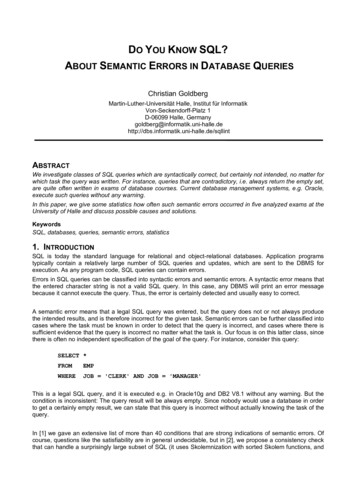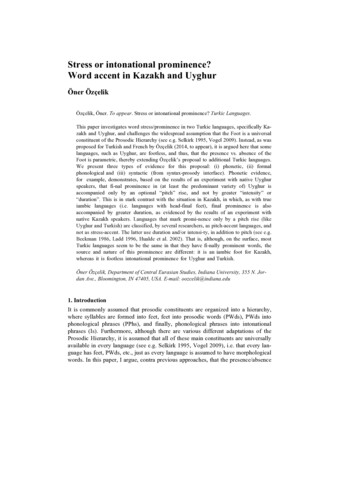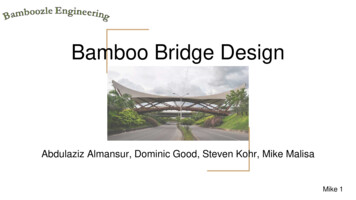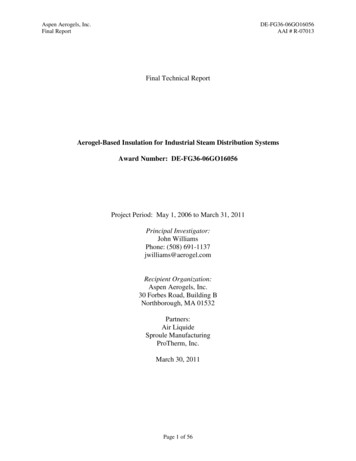
Transcription
PROTECTING andEMPOWERINGEVERY LAST GIRLan impact analysis of apne aapwomen worldwide, 2002-2015Lise McKean, Ph.D.
PROTECTING AND EMPOWERING EVERY LAST GIRLAN IMPACT ANALYSIS OF APNE AAP WOMEN WORLDWIDE, 2002-2015LISE MCKEAN, PH.D.MARCH 2016Before you do anything, stop and recall the face of the weakest person you haveseen, and ask yourself: Is what I’m about to do going to help him or her regaincontrol of their destiny?Mahatma GandhiEXECUTIVE SUMMARYJournalist-turned-activist Ruchira Gupta founded Apne Aap Women Worldwide (AAWW) in 2002 in the context ofbuilding a movement to end the trafficking of women and girls into prostitution. AAWW is a registered charitabletrust in India. It has consultative status with the United Nations. Apne Aap International is registered as a 501 (c)(3)not-for-profit organization in the United States to raise awareness and funds for AAWW. In its 14-year history,AAWW has grown from a startup to a mature NGO that offers lessons for other social justice organizations.Learning, giving, and sharing are key to AAWW’s ethos.AAWW applies what it learns in the course of doing its work. It learns from grassroots members, from experts, andfrom opponents. It learns from its partners in a cross section of social movements: the women’s movement, humanrights movement, labor movement, and child protection movement. It learns and applies new lessons as the yearspass and the political, economic, legal, social, and cultural contexts of its work change. This report itself stems fromAAWW’s commitment to learning and participating in discussions and debates on grassroots-based social justiceactivism.A systemic and intersectional analysis of the distribution of power and resources informs the work of AAWW.Namely, AAWW considers trafficking into prostitution to be inextricable from poverty, social exclusion, andviolence and discrimination against girls and women. Gandhian principles of ahimsa (nonviolence to self andothers) and antyodaya (empowerment of the weakest and poorest of the poor) are at the core of AAWW’s work ofbuilding a social justice movement to stop trafficking into prostitution.Democratic principles of empowerment through civic education leading to individual and collective action also arekey to AAWW’s approach. Its grassroots work targets localities in Bihar, New Delhi, and Kolkata that haveconcentrations of women and girls who have been or are vulnerable to being trafficked into prostitution. AAWWstaff gradually established a presence in these communities, first through outreach and later by providing a safeplace for women and girls to meet, obtain information and assistance in accessing resources, and participate in selfempowerment groups.Its work to empower women and girls who have been or are vulnerable to being trafficked has three strands: service,organization, and advocacy focusing on: ProtectionPreventionProsecutionIn turn, each of these strands is geared to empowering women and girls to exercise their rights to: Safe spaceLegal protectionEducationLivelihood
Based on what was learned from women and girls in its community centers and self-empowerment groups, AAWWformulated an innovative approach to structure and track specific activities of members directed toward attaininglegal rights and entitlements that foster empowerment. This grassroots-centered approach identifies the selfempowerment group as the unit for individual and collective organizing and for participation in the anti-traffickingmovement. AAWW calls this approach 10 x 10. Members work together in self-empowerment groups of 10 womenor girls to support each other on the path to attaining ten fundamental assets that support their fundamental rights.The full report includes an examination of AAWW’s work in grassroots organizing, public awareness and mediacoverage, and advocacy during the periods 2002–2009 and 2009–2015; a case study of the girls’ residential middleschool, Kasturba Gandhi Balika Vidyalaya (KGBV) in Simraha, Bihar, established by AAWW in 2007; andassessments of AWW’s leadership and institutional sustainability. To provide a snapshot of AAWW’s work inrecent years, highlights of its accomplishments from 2009–2015 are presented below.Highlights of accomplishments in the area of grassroots organizing during this period include: Involving over 18,500 girls and women who are victims of or vulnerable to trafficking as AAWW membersInvolving 65% of members in self-empowerment groupsSupporting 50% of members in obtaining voting and/or ration cardsLinking members with the NOMI network for sustainable livelihoodsSupporting 12% of members in filing police complaints or taking action against pimps or traffickersHelping 124 self-empowerment groups to open bank accounts and participate in micro-savings programsOrganizing one national and two state-level conferences of trafficking and prostitution survivorsHighlights of accomplishments in the area of public awareness and media coverage during this period include: Coordinating AAWW members who are college students to present a petition to the Chief Minister ofBihar requesting more schools and hostels for at-risk girlsPublishing the Red Light Dispatch that features writings by AAWW membersOrganizing the “Cool Men Don’t Buy Sex” campaign to educate students, male youth, and mainstreammedia about the need for anti-demand laws that criminalize traffickers and punish men for the purchase ofsex, and to collect petitions in support of legislative change. The campaign reached an estimated 40,000–50,000 people.Organizing the “Be Aware Campaign,” with activities in New Delhi at the India Art Fair, Shahpur Jat, theSelect City Walk on International Women’s Day, and AAWW’s Field Centre in DharampuraServing as NGO engagement partner for Priya’s Shakti, a graphic novel published by RattapallaxProduction that features a heroic woman fighting to end gender-based sexual violence in India and aroundthe worldHosting the Terrace Talk Series at AAWW’s New Delhi office to raise public awareness about the antitrafficking movementCollaborating with the US Consulate on an anti-trafficking awareness campaign among South Asianimmigrants in the United StatesArranging for students from AAWW’s residential school in Bihar to meet with US Secretary of StateHillary ClintonHosting the visit, sponsored by the NoVo Foundation, of 15 leaders in the movement to end violenceagainst women to acquaint them with AAWW’s grassroots work and the 10 x 10 and Last Girl approachesHosting the visit of feminist writer Eve Ensler to AAWW in New Delhi to meet with AAWW staff andcommunity leaders Fatima Khatoon and M. KalamInvolving Ashley Judd in the AAWW Leadership Council and receiving mention in her 2011 memoir, AllThat Is Bitter and SweetEstablishing relationships with writers and activists and receiving mention in their books: Half the Sky byNicholas D. Kristoff and Sheryl WuDunn (also a documentary film); Sold by Patricia McCormick; Town ofLove by Anne Ch. Ostby; and As if Women Matter by Gloria Steinem, edited by Ruchira GuptaExpanding AAWW’s social media presence on Facebook (8,821 likes and 11,421 members in Apne Aap’sGroup) and Twitter (1,941 Tweets and 541 following) (March 2016)2
Highlights of accomplishments in the area of advocacy for 2009–2015 include: Leading a group of AAWW members to a meeting of the UN Human Rights Council in Geneva, where theAAWW panel members spoke alongside the UN High Commissioner for Human RightsProviding leadership on advocacy to eliminate provisions of the Immoral Traffic (Prevention) Act, 1956,that penalize solicitation of clients in public placesCoordinating AAWW members to testify before the Justice Verma Committee on Amendments to CriminalLawParticipating in legislative advocacy that resulted in passage of the Criminal Law (Amendment) Act, 2013,which for the first time included trafficking as a criminal offence in the Indian Penal CodeParticipating in advocacy that led to a UN General Assembly resolution establishing July 30 as the WorldDay against Trafficking in PersonsParticipating in advocacy that led to the establishment of the UN Voluntary Trust Fund for Victims ofTrafficking in Persons, Especially Women and ChildrenCollaborating with Housing and Land Rights Network (HRLN) on research and advocacy on forcedevictions in KolkataThe challenge for any organization—and particularly for AAWW given the extraordinary range and depth of Ms.Gupta’s leadership abilities—is sustaining its mission and momentum when the mantle of leadership passes to thefounder’s successor. AAWW is well positioned to meet this challenge as it transitions to a new leader. That is, 2016marks the year that Ms. Tinku Khanna, the first person hired by AAWW and who has been a close colleague of Ms.Gupta for over a decade, takes the reins as the founder moves out of day-to-day leadership of AAWW and into therole of President.The future of AAWW is embedded in India’s changing political, economic, and social landscape—withconsiderable regional differences among its program sites. With so many variables at play, planning for AAWW’sfuture is a complex and fluid process. Whatever the successes that occur in terms of organizing, public awarenessand media coverage, and advocacy, the day-to-day enforcement of anti-trafficking laws, prosecution and punishmentof criminals, and implementation of victim support programs require constant struggle and enormous expenditure oftime and resources.With their focus on individual and collective asset building and empowerment, AAWW and grassroots-centeredsocial justice movements are committed to the long-term work of structural change. This commitment is fueled bythe passion to fight against injustice wherever and however it manifests itself in society. AAWW is an organizationwhere grassroots leaders grow—and their knowledge of their communities is respected and valued. As theirexperience in organizing, management, and advocacy at all levels increases over time, community-grown leaderssuch as Fatima Khatoon and M. Kalam are playing larger and larger leadership roles within AAWW, within otherNGOs, and across anti-trafficking and social justice movements in India and around the world.3
PROTECTING AND EMPOWERING EVERY LAST GIRLAN IMPACT ANALYSIS OF APNE AAP WOMEN WORLDWIDE, 2002-2015LISE MCKEAN, PH.D.MARCH 2016APNE AAP WOMEN WORLDWIDE IN CONTEXTJournalist-turned-activist Ruchira Gupta founded Apne Aap Women Worldwide (AAWW) in 2002 in the context ofbuilding a movement to end the trafficking of women and girls into prostitution. AAWW is a registered charitabletrust in India. It has consultative status with the United Nations. Apne Aap International is registered as a 501 (c)(3)not-for-profit organization in the United States to raise awareness and funds for AAWWThe first part of this study presents an overview of this context and introduces the Gandhian principles and theory ofchange that guide AAWW’s approach to individual and collective empowerment of women and girls. Subsequentparts of the study comprise: an examination of AAWW’s work in grassroots organizing, public awareness and mediacoverage, and advocacy during the periods 2002–2009 and 2009–2015; a case study of the girls’ residential middleschool, Kasturba Gandhi Balika Vidyalaya (KGBV) in Simraha, Bihar, established by AAWW in 2007; andassessments of AWW’s leadership and institutional sustainability.Creating a Movement to End Trafficking of Women and Girls into ProstitutionThe Selling of Innocents, an Emmy award–winning documentary about the trafficking of Nepali girls intoprostitution in India, marks its 20th anniversary in 2016.1 Working on the documentary marks a turning point forjournalist Ruchira Gupta. Once she witnessed the reality of trafficking, she placed the fight to protect and empowergirls and women—and to end trafficking—at the center of her life. For the last 20 years, her focus has been buildinga movement centered on the voices and needs of the most vulnerable women and girls.Ms. Gupta leveraged her status as an Emmy awardee, along with her professional expertise and social networks, tobring the issue of trafficking to the attention of national and global leaders and policymakers: the Indiangovernment, the US Congress, and the United Nations. Her work for USAID included developing anti-traffickingplans for Bangladesh, Cambodia, Indonesia, Kosovo, Laos, Philippines, Thailand, and Vietnam. In 2002 Ms. Guptareturned to India and founded the NGO AAWW.In its 14-year history, AAWW has grown from a startup to a mature NGO that offers lessons for other social justiceorganizations.2 Learning, giving, and sharing are key to AAWW’s ethos. AAWW applies what it learns in the courseof doing its work. It learns from grassroots members, from experts, and from opponents. It learns from its partners ina cross section of social movements: the women’s movement, human rights movement, labor movement, and childprotection movement. It learns and applies new lessons as the years pass and the political, economic, legal, social,and cultural contexts of its work change. This report itself stems from AAWW’s commitment to learning andparticipating in discussions and debates on grassroots-based social justice organizing and activism.31The Emmy was awarded to The Selling of Innocents for Outstanding Investigative Journalism in 1996.The term, non-governmental organization (NGO) encompasses what are known in India as charitable trusts and in the UnitedStates as 501 (c)(3) not-for-profit organizations.3The author of this is study, Dr. McKean, is a social anthropologist who has been conducting research in India since 1987. She hasbeen in conversation with Ms. Gupta about AAWW since its founding and made site visits to AAWW’s community center andheadquarters in New Delhi for meetings with staff and members. In 2013 she went to program sites in rural Bihar and met with theDistrict Magistrate and Superintendent of Police during a fact-finding mission related to police harassment of AAWW staff.24
Opponents, Controversy, and Hard NumbersThe principles underpinning AAWW’s position on trafficking and its opposition to the legalization of prostitutionare not without opponents in India, the United States, and elsewhere. For example, sociologist Ronald Weitzerwrites articles for academic journals that criticize the movement to end trafficking into prostitution. He and likeminded academics argue that the anti-trafficking movement enormously overstated how many women and girls aretrafficked or at risk of being trafficked into prostitution in order to sway policy debates. Their evidence is the factthat later figures used by the US Government and the UN were much smaller. At the same time they concede thatsubstantial difficulties in obtaining valid data result in a lack of credible data. That is, it is hard to get hard numberson prostitution and human trafficking of all kinds.Critics also charge the movement with neglecting the larger number of people who are trafficked as laborers andsubjected to human rights violations. For some critics, however, the disagreement centers on the anti-traffickingmovement’s definition of prostitution as a violation of human rights and its staunch opposition to the legalization ofprostitution. They argue that criminalization of prostitution makes it more dangerous for women, some of whommake a rational economic and personal choice to work as prostitutes.Over the past 20 years, the public, politicians, and policymakers have found advocates from the anti-traffickingmovement such as Ms. Gupta and Apne Aap more persuasive than proponents of legalized prostitution. Thoseworking to protect women and girls from being trafficked into prostitution acted strategically through public andprivate institutions and the media, and attracted influential persons to support their cause. Before founding AAWW,Ruchira Gupta was at the forefront of the movement, and since its founding, AAWW has strengthened theconnections between the grassroots and advocacy for legislative and policy change.Professor Weitzer’s 2007 article, “The Social Construction of Sex Trafficking: Ideology and Institutionalization of aMoral Crusade,” offers a framework for understanding the process whereby this “moral crusade,” which othersregard as a movement for social justice, established institutional power.4 Consultation and inclusion of activists in policymakingOfficial recognition and endorsement of ideologyOfficials’ independent articulation of ideologyProgrammatic and legal changes in accordance with ideologyThe policy and legislative successes of the anti-trafficking movement have been hard fought within national andinternational institutions such as the Indian Parliament, US Congress, and UN. Sustaining these political successes,however, requires ongoing effort and strong partnerships with broadly based social movements. Hence, AAWW’scommitment to situating anti-trafficking work within a range of social justice movements.The Last Girl and AAWW’s Theory of ChangeIn his recent book, The Country of First Boys, Nobel prize-winning economist Amartya Sen reflects on the culturalvalues and political and social institutions in India that nurture, privilege, and reward first boys.5 He notes that thesame values and institutions penalize the poor—and particularly last girls. The deprivation and hardship associatedwith poverty are compounded by discrimination against girls and women as well as by caste and religiousprejudices. Professor Sen indicts India’s government and politically influential upper and middle classes for theirdismal record on providing basic needs such as water, toilets, housing, food, health care, education, and employmentto large sectors of the population.A systemic and intersectional analysis of the distribution of power and resources informs the work of AAWW.Namely, AAWW considers trafficking into prostitution to be inextricable from poverty, social exclusion, andviolence and discrimination against girls and women. Gandhian principles of ahimsa (nonviolence to self and4Ronald Weitzer, “The Social Construction of Sex Trafficking: Ideology and Institutionalization of a Moral Crusade,” Politicsand Society 35, no. 3 (2007): 458.5 Amartya Sen, The Country of First Boys (New York: Oxford University Press, 2015).5
others) and antyodaya (empowerment of the weakest and poorest of the poor) are at the core of AAWW’s work ofbuilding a social justice movement to stop trafficking into prostitution.The “last” girl is Gandhi’s weakest person. She is weaker than the poor, low-caste man because she isfemale. She is weaker than the poor low-caste man’s wife because she is a teenager and no one respects herwishes or rights at all—to go to school or help at home, to not marry or be prostituted, what to wear, whento eat.6Antyodaya is central to the theory of change guiding AAWW. The movement to end trafficking identifies andchanges the conditions that make girls and women vulnerable to being trafficked—conditions that deprive girls andwomen of the right to make choices about their education and livelihood. The principle of antyodaya is egalitarianand cooperative. Those who have the advantages of education, social connections, and economic security offer themin service of those most in need. They work alongside the weakest and most vulnerable women and girls and learnfrom them.AAWW’s Evolving Model of EmpowermentWhen AAWW was founded in 2002, there were no organizations with evidence-based best practices on which tomodel grassroots anti-trafficking work. During her years in the United States, Ms. Gupta worked in high-level policyand advocacy environments. AAWW was created as an organization to protect, organize, and empower Indian girlsand women who are victims of trafficking or at risk of being trafficked into prostitution.Poverty, discrimination against women and girls, armed conflict, and natural disaster are widely acknowledged asdrivers of trafficking women and girls into prostitution. For instance, intergenerational prostitution occurs whenwomen in prostitution become ill or are no longer young and are without other means of survival; this increases theirdaughters’ risk of being sold or forced into prostitution. These drivers vary enormously from one country to another,within a single country, from locale to locale, and among different social groups.Drivers, however, are nothing without demand. Specific contexts allow trafficking to thrive, to be tolerated, or to betargeted for elimination. Furthermore, there is considerable variation from place to place in the extent to whichtrafficking into prostitution is enmeshed in the larger black economy of the criminal underworld with its attendantpolice and political corruption and linkages to trafficking of labor, drugs, and weapons. AAWW recognizes that theproblem of demand must also be addressed. Accordingly, it does not support the legalization of prostitution. Itadvocates a “middle way”: criminal prosecution of traffickers (including agents and pimps); penalization of clients(johns); and decriminalization of women and girls in prostitution.Along with Gandhian principles and movement-building strategies, AAWW benefits from India’s rich tradition ofwomen-led organizing and activism. For example, SEWA, a trade union for poor, self-employed Indian women, wasformed in 1972 as a means of collaborative empowerment. Beyond SEWA, decades of women-centereddevelopment and anti-poverty work in urban and rural settings by NGOs and government programs also provideimportant lessons and precedents for AAWW’s work.7Democratic principles of empowerment through civic education leading to individual and collective action also arekey to AAWW’s approach. Its grassroots work targets localities in Bihar, New Delhi, and Kolkata that haveconcentrations of women and girls who have been or are vulnerable to being trafficked into prostitution. AAWWstaff gradually established a presence in these communities, first through outreach and later by providing a safeplace for women and girls to meet, obtain information and assistance in accessing resources, and participate in selfempowerment groups.6AAWW Annual Report, 2013–2014: 5.The Mahila Samakhya program, another important model of women’s organizing and collective action, was established in 1988to pursue the objectives of the 1986 National Policy on Education. For data and analysis of this program, see “Mahila Samakhya:A National Review” (Ahmedabad: Ravi J. Matthai Centre for Educational Innovation, Indian Institute of Management,Ahmedabad, 2014).76
AAWW’s grassroots work contributes to building the larger anti-trafficking movement. Through AAWW’spartnerships within India and internationally, the voices of trafficked and at-risk women and girls inform both publicawareness about trafficking and anti-trafficking policies and legislation.Its work to empower women and girls who have been or are vulnerable to being trafficked has three strands: service,organization, and advocacy focusing on: ProtectionPreventionProsecutionIn turn, each of these strands is geared to empowering women and girls to exercise their rights to: Safe spaceLegal protectionEducationLivelihoodBased on what was learned from women and girls in its community centers and self-empowerment groups, AAWWformulated an innovative approach to structure and track specific activities of members directed toward attaininglegal rights and entitlements that foster empowerment. This grassroots-centered approach identifies the selfempowerment group as the unit for individual and collective organizing and for participation in the anti-traffickingmovement. AAWW calls this approach 10 x 10. Members work together in self-empowerment groups of 10 womenor girls to support each other on the path to attaining ten fundamental assets:1.Safe spaceAccess AAWW community center, hostel, shelter, low-cost housing, and land2.EducationAttend adult literacy classes, health and sexuality awareness classes, and bridge programs for girls tomiddle school, residential school, high school, and college3.Self-confidenceContribute two articles to AAWW publications; deliver two speeches; participate in two media interactions4.Political powerCreate one anti-trafficking slogan, one poster, and one song; file one official form or petition; participate inone rally, one tribunal, one interaction with government or political authorities5.Government IDsObtain legal documents: birth certificate, voter ID card, BPL card, ration card; SC/ST/OBC certificate, Pancard; Aadhar Card; passport6.Government entitlement programsAccess government entitlement and subsidy programs: food and household rations, low-cost loans, landsubsidies, and other government programs (NREGA/MGNEGRA; Indira Aawas Yojana; RashtriyaSwasthiya Bima Yojna; Janani Suraksha Yojana; Integrated Child Development Scheme; Pradhan MantriJan Dhan Yojana; Rijiv Awas Yojana)7.Savings and loansParticipate in self-empowerment group’s savings account; open post office savings account and bankaccount7
8.Livelihood linkageParticipate in programs to develop two vocational skills (embroidery, computers/BPO; bag, scarf, quiltmaking; dance and art; participate in small business activity (food preparation; bag, quilt, and scarf making;sanitary towel making)9.Legal empowermentReceive legal training on rights; make visit to police and court; escort someone to file police complaint;receive training to testify in court10. Self-empowerment groupParticipate with nine friends in self-empowerment group; become involved in AAWW networkAAWW IN REVIEW, 2002–2015Insufficient or inadequate laws, poor enforcement, ineffective penalties, minimal chancesof prosecution, the relatively low risks involved, corruption and complacency, invisibilityof the issue, the failure of governments to implement policies and provide adequateservices for victims all play a role in perpetuating trafficking.PM Nair8The written documentation of AAWW’s work since its formation includes: four impact assessments by internationalconsulting firm Dalberg Development Advisors; AAWW’s annual reports and reports on the residential girls’ schoolit founded in 2007; and press coverage of AAWW and Ms. Gupta.9 These materials chronicle the scope and contentof AAWW’s work over time and provide important indicators of its impact.8PM Nair, “A Report on Trafficking in Women and Children in India, 2002–2003” (National Human Rights Council of India,Institute of Social Sciences, and United Nations Development Fund for Women).9The four reports by Dalberg Development Advisors are: “Apne Aap Women Worldwide: A High Level Impact Assessment,2002–2009”; “Apne Aap Women Worldwide: A High Level Impact Assessment, 2009–2015”; “Impact Assessment Report of‘Cool Men Don’t Buy Sex’ Campaign, 2014”; and “Apne Aap Leadership Impact Assessment, 2014.” AAWW materials include:AAWW annual reports for 2007–2014; AAWW Projects, 2006-2015; AAWW’s two reports on its residential school, “Kasturba8
Starting Up and Taking Root: AAWW 2002–2009In its impact assessment of AAWW for 2002–2009, Dalberg stated that when measured against its targets, AAWWis “an organization that has overwhelmingly delivered on its commitments.”10 The Dalberg study acknowledged theconsiderable challenges facing the startup, including threats from traffickers, police, and other vested interests aswell as the delicate nature and substantial time required for AAWW staff to earn the trust of the women and girlsthey were reaching out to.Grassroots OrganizingDuring its first seven years, AAWW established community centers in red-light areas of New Delhi, Kolkata,Maharashtra, and Bihar. The community centers offered a base for AAWW’s work of establishing its credibility.Membership in AAWW is designed to be inclusive rather than exclusive. Attendance and participation in AAWWactivities constitutes membership, allowing women and girls to determine the level of participation that best suitstheir situation and needs. Over time key elements were identified as essential to attracting and sustaining interest andinvolvement of members: Demonstrating that children’s involvement in the community center could be a step to formal educationEngaging women involved in prostitution and at-risk girls by listening and learning about their needsOffering a model of self-organization and collective decision makingDuring these years, AAWW developed its model of organizing as a pathway to employment. Its steps include: Forming collectives where women and girls meet and share experiencesTraining to build capacity to run income-generating projects and access employmentRegistering the collective as a self-empowerment group to access government programs, loans, and legalprotectionsAccessing dignified livelihood opportunities and services as a rightHighlights of accomplishments in the area of grassroots organizing during this period include: Involving over 10,000 women and children in activities at AAWW community centers known asAntyodaya Bal Vikaskenna (ABVK)Involving 126 girls in Youth Groups (Kishori Mandal) by 2009. The groups offer dance therapy, instructionin computers, karate, sewing, and embroidery; they provide economic benefit and promote physical andemotional well-being and social dignity.Involving 136 women in self-empowerment groups (Mahila Mandal). Through weekly meeting the groupsbuild individual and collective morale through learning how to: access health and legal services; accessdocuments to enroll in government entitlement and employment programs; participate in micro-loanprograms; open a group bank account; and file a police complaint.Targeting 15 Bihari villages with 45,000 persons displaced by the Kosi Flood for Youth and Women’sGroups to reduce vulnerability to traffickingEstablishing the Kasturba Gandhi Bal Vidyalaya (KGBV) residential middle school for girls in Bihar in2007 with 50% of
4 PROTECTING AND EMPOWERING EVERY LAST GIRL AN IMPACT ANALYSIS OF APNE AAP WOMEN WORLDWIDE, 2002-2015 LISE MCKEAN, PH.D. MARCH 2016 APNE AAP WOMEN WORLDWIDE IN CONTEXT Journalist-turned-activist Ruchira Gupta founded Apne Aap Women Worldwide (AAWW) in 2002 in the context of building a movement to end the trafficking of women and girls into prostitution.
